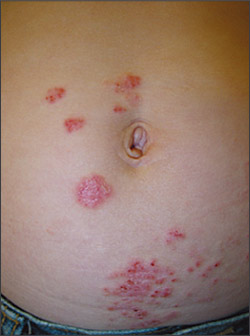
Am Fam Physician. 2005;72(5):871-873
A woman brought her nine-year-old son in because of a pruritic rash on his abdomen (see accompanying figure). The rash was isolated to the abdomen, although the child had incidental keratosis pilaris on his extensor arms. There was a family history of atopy, but the child was otherwise healthy.

Question
Based on the patient’s history and physical examination, which one of the following is the correct diagnosis?
A. Tinea corporis.
B. Allergic contact dermatitis.
C. Irritant contact dermatitis.
D. Nummular eczematous dermatitis.
E. Fixed drug eruption.
Discussion
The answer is B: allergic contact dermatitis. In this patient, the contact allergen is nickel, arising from contact with the inside of the nickel-containing metal snap on the button of the child’s jeans. Pruritic dermatitis near the umbilicus or on the earlobes almost always is the result of nickel allergy. Sensitization to nickel in childhood is caused most often by piercing of ears and insertion of nickel-plated earrings.1
Contact dermatitis can be classified as irritant contact, allergic contact, photo contact, and contact urticaria. Once diagnosed, most cases of contact dermatitis are self-limited and easily treated.
Allergic contact dermatitis occurs when a genetically susceptible person has repeated contact with an allergen, resulting in a type IV hypersensitivity reaction.2 The two distinct phases of a type IV hypersensitivity reaction are the sensitization phase and the elicitation phase. It affects approximately 20 percent of all children at some time, is twice as common in females as in males, and occurs more often in whites, especially those with fair skin and red hair.3
The morbidity from allergic contact dermatitis depends on its cause and the possibility of avoiding repeated or continued exposures. Clinically, allergic contact dermatitis usually is more severe and acute in onset than irritant contact dermatitis, and often is pruritic. It can present acutely (bright red skin, edema, vesicles), subacutely (less edema and erythema, minimal vesiculation or serous drainage, excoriations), or chronically (scaling, fissuring, lichenification, mild erythema, excoriations).
Diagnosis usually is determined by a good history and physical examination. Patch testing may suggest or confirm the etiologic agent in allergic contact dermatitis, but biopsies are of little diagnostic help.
Once the correct diagnosis has been established, many patients improve by avoiding the allergen. Some ubiquitous allergens, such as rubber or nickel, are impossible to avoid completely. Exposure can be reduced with careful instruction.4 In the case of nickel, avoiding jewelry containing nickel and placing adhesive tape over the inside of the jeans button can reduce exposure. However, occult exposures may produce chronic or recurrent symptoms. Table 1 provides clues to allergic contactants by location of the reaction on the body.
Many cases of localized mild contact dermatitis respond well to cool compresses (with isotonic sodium chloride solution or Burow’s solution) and adequate wound care. Usually, potent topical steroids (e.g., class II or III), applied twice daily for two to three weeks, are effective for treating small areas of moderate allergic contact dermatitis (stopping too quickly can cause rebound dermatitis).3 The new topical immunomodulators such as tacrolimus (Protopic) and pimecrolimus (Elidel) have shown benefit but remain second-line therapies. Antihistamines, such as hydroxyzine (Atarax) or diphenhydramine (Benadryl), can be useful in patients with severe pruritus and impaired sleep. Systemic steroids are indicated only when more than 10 percent of the body surface area is involved.5
| Location | Allergic contactant |
|---|---|
| Scalp and ears | Shampoo, hair spray, hair dye, earrings, eyeglasses |
| Eyelids | Cosmetics, sport goggles |
| Face | Cosmetics, sunscreen, perfume |
| Lips | Lip balms, lipstick, toothpaste, food |
| Neck | Necklaces, perfumes, aftershave lotion |
| Trunk | Sunscreens, clothing, metal belt or buckle, elastic waistband |
| Axillae | Deodorant (axillary vault), clothing (axillary folds) |
| Hands | Soaps and detergents, foods, cement, gloves, poison ivy, solvents |
| Wrists | Hand contactants, watch, watchband, bracelets |
| Genitals | Poison ivy, condoms |
| Legs | Dye in socks, topical medications (e.g., lanolin, benzocaine [Americaine]) |
| Feet | Rubber, leather, glues, dyes, topical medications |
| Condition | Characteristics |
|---|---|
| Tinea corporis | Annular, erythematous, and slightly scaly plaque that expands over time |
| Allergic contact dermatitis | Pruritic erythematous and edematous plaques with excoriations |
| Irritant contact dermatitis | Erythema, mild edema, and scaling with resultant symptoms of pain, stinging, or discomfort |
| Nummular dermatitis | Discrete, round, pruritic plaques in random locations |
| Fixed drug eruption | Solitary, red to purple patches or plaques with recurrences at the same site, temporal relation to medication |
Tinea corporis is a superficial dermatophyte infection that often begins as an annular, erythematous, and slightly scaly plaque that expands over time. It is not particularly pruritic.
Irritant dermatitis is inf lammation of the skin characterized by erythema, mild edema, and scaling with resultant symptoms of pain, stinging, or discomfort. Pruritus is a minor feature at most. The most common causes are soaps and detergents; other irritants include acids, alkalis, plants, and chlorine.
Nummular (“coin-like”) eczematous dermatitis is an idiopathic disease that manifests as discrete, round, pruritic plaques in relatively random locations (rather than in a specific area).
Fixed drug eruptions are solitary, red to purple patches or plaques that are occasionally bullous. They recur at the same site in response to an offending medication. A differential diagnosis of periumbilical pruritic plaques is provided in Table 2.